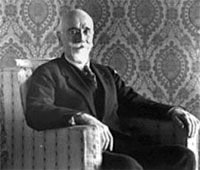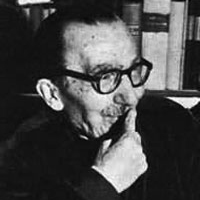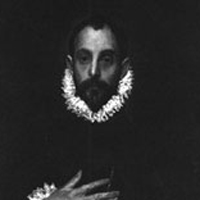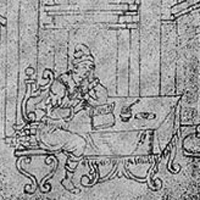
Prominent persons in Crete
Venizelos, Eleftherios / 1864 - 1936
 There is hardly a place on Crete where one doesn't find a statue or at least a street, which isn't named after him. Not only Crete, but also the rest of Greece has been strongly
influenced by him, although it is the Cretans, which have to thank him for the unification with the motherland in 1913, after an untiring fight. Venizelios personally raised the
Greek flag in his hometown of Chania. Between 1910 and 1933 he held the office of Prime Minister eight times. During his period of office he pushed through considerable political
reforms.
There is hardly a place on Crete where one doesn't find a statue or at least a street, which isn't named after him. Not only Crete, but also the rest of Greece has been strongly
influenced by him, although it is the Cretans, which have to thank him for the unification with the motherland in 1913, after an untiring fight. Venizelios personally raised the
Greek flag in his hometown of Chania. Between 1910 and 1933 he held the office of Prime Minister eight times. During his period of office he pushed through considerable political
reforms.
Eleftherios Venizelos was born in Chania, in 1864. His family came from Sparti and came to the island when Benizelo Krevatas moved here in 1790 and gave his name to the famous family of Venizelos. Eleftherios had a difficult childhood, as the revolution forced his father to leave the island and move to Syros, where the young boy had his first education. After a PhD in Law, he left Athens in 1886 to return to his hometown. He soon was involved in politics and was elected congressman at the Cretan Council; he later became Minister of Justice. In 1905 he was the leader of United Opposition Party, while in 1908 he was again appointed Minister of Justice and Foreign Affairs. After his intervention in the negotiations between the "rebels", the Crown and the Political Parties, he was elected "President of the Greek Council of the Cretans" and Prime Minister of Crete, in 1910. Within the next months he became the leader of the Liberal Party, won the elections of the Revisory Parliament (December 1910) and thrived at the next elections (March 1912). In 1916, he established at Chania - along with Daglis and Koundouriotis - the National Triumvirate, forming a temporary government of National Defence. He lost the elections of 1920 and went abroad. In 1923, Venizelos represented Greece at the Treaty of Lozanne, signing the treaty of exchanging populations. Later in that year, he came back to Greece and became governor, only to quit within a short period of time. In the following years, Venizelos was on and off the government until he lost the elections of 1933. Later that year, someone attempted to murder him at Kifissias Ave. Venizelos died in Paris, in March 1936. He was buried at Akrotiri Chanion.
Nikos Kazantzakis / 1883 - 1957
 One of the most important Greek writers, poets and philosophers of the 20th century, was born in Iraklion in 1883. He became famous, during the last years of his life, when he turns to pezography. During that time he published, among others, Zorba the Greek (Vios kai politeia tou Alexi Zorba), The Last Temptation of Christ (O teleutaios peirasmos), Freedom and Death (O Kapetan Mihalis), The Greek Passion (O Hristos ksanastauronetai), and his autobiography Report to Greco (Anafora ston Greco). His book, The Last Temptation of Christ, was considered quite controversial when first published in 1955, and prompted angry reactions from both the Roman Catholic Church, which banned it, and from the Greek Orthodox Church, which excommunicated him! In 28th of June 1956, in Vienna, he was awarded the International Peace Award.
One of the most important Greek writers, poets and philosophers of the 20th century, was born in Iraklion in 1883. He became famous, during the last years of his life, when he turns to pezography. During that time he published, among others, Zorba the Greek (Vios kai politeia tou Alexi Zorba), The Last Temptation of Christ (O teleutaios peirasmos), Freedom and Death (O Kapetan Mihalis), The Greek Passion (O Hristos ksanastauronetai), and his autobiography Report to Greco (Anafora ston Greco). His book, The Last Temptation of Christ, was considered quite controversial when first published in 1955, and prompted angry reactions from both the Roman Catholic Church, which banned it, and from the Greek Orthodox Church, which excommunicated him! In 28th of June 1956, in Vienna, he was awarded the International Peace Award.He died in 1957 in Germany and is buried on one of the bastions of the Venetian fort surrounding Heraklion, Martinego. In the Historical Museum of Crete there is a room devoted to Nikos Kazantzakis. His desk, library, some of his personal belongings as well as manuscripts of many of his works are displayed. He's one of the most significant Greek novelists, poets, drama writers and scholars. He was born in Heraklion, in 1833 and studied Law in Athens and Philosophy in Paris. He was influenced by the theories of Ion Dragoumis and Eleftherios Venizelos. His trip to Russia in 1919, acting as General Manager of the Ministry of Welfare, was the introduction of his exciting odyssey: Vienna, Berlin, Italy, Crete, Russia, Cyprus, Spain, Egypt, mount Sinah, Goethesgub (Tsechoslovakia), Nice (France). He died in Germany, in 1957. His first novel was "The Snake and the Lilly", in 1906, followed by "Foreman", "Ascetic Life", the translation of Dante's "Divina Comedy". His prime was evident by the works "Life of Alexis Zorbas", "Christ is crossed again", "Captain Michael", "The Last Temptation", "God's Poor Man" and "Reference to Greco".
El Greco / 1541 - 1614 (real name - Domenico Theotokopoulos)
 The Spaniards gave the painter the name of El Greco. The painter grew up in Heraklion where he later learnt the art of icon painting from Michael Damaskenos. El Greco left his homeland in 1565 and went to Toledo, where he died as a famous painter in 1614.
The Spaniards gave the painter the name of El Greco. The painter grew up in Heraklion where he later learnt the art of icon painting from Michael Damaskenos. El Greco left his homeland in 1565 and went to Toledo, where he died as a famous painter in 1614.Domenicos Theotokopoulos was born in Heraklion, in 1541. He was first taught hagiography at a Venetian workshop and was influenced by the Cretan Hagiographic School (16th century) and the Byzantine art. He spent most of his life in Toledo, Spain, where he died in 1614. El Greco, as he was called, occupied with sculpture and architecture, although the only samples of his work are the sculpt icon- stands in Santo Domingo el Antiguo (1577), the chapel of San Jose in Toledo (1597-1599) and the church of Mercy Hospital in Ilieskas (1603 - 1605). El Greco's painting follows the four cities where he lived: Heraklio, Venice, Rome and Toledo. The most known of his work are: "Boy blowing the coal", "Holy Trinity", "St. John Baptist", "Mercyful Virgin Mary", "The "Ascention of Virgin Mary" and others.
Vincenzos Kornaros / 17th century ~ 1677
 Although there is no definite information about Vicenzos Kornaros, it is known that he lived in Sitia and Heraklio in the 17th century and died in 1677. Kornaros is said to have written the famous cretan work of literature "Erotokritos". This terrifice narrative piece was written in 10,000 15-syllable verses. There is only one remaining copy, dated back in 1710. The work was first published in Venice, in 1713. Even though the plot is trivial, it is said that Kornaros was inspired by the French medieval play "Paris and Vienne", which he turned in a literal masterpiece. Kornaros is said to have written the poetic drama "Abraham's Sacrifice" which consisted of 1,154 15-syllable verses and was first published in 1635. His ideal was the tragedy "Isaac", by Italian L. Grotto.p>
Although there is no definite information about Vicenzos Kornaros, it is known that he lived in Sitia and Heraklio in the 17th century and died in 1677. Kornaros is said to have written the famous cretan work of literature "Erotokritos". This terrifice narrative piece was written in 10,000 15-syllable verses. There is only one remaining copy, dated back in 1710. The work was first published in Venice, in 1713. Even though the plot is trivial, it is said that Kornaros was inspired by the French medieval play "Paris and Vienne", which he turned in a literal masterpiece. Kornaros is said to have written the poetic drama "Abraham's Sacrifice" which consisted of 1,154 15-syllable verses and was first published in 1635. His ideal was the tragedy "Isaac", by Italian L. Grotto.p>
